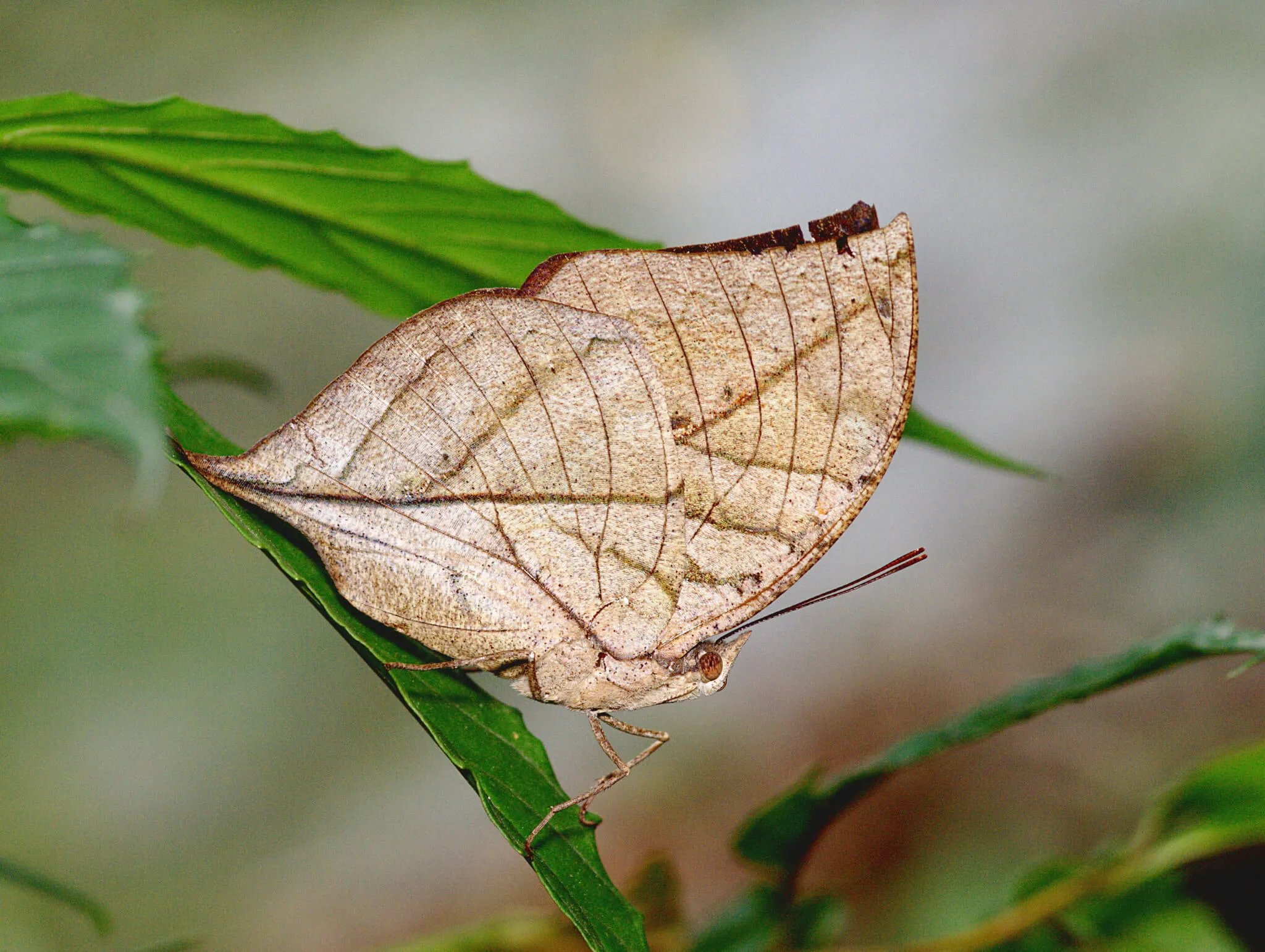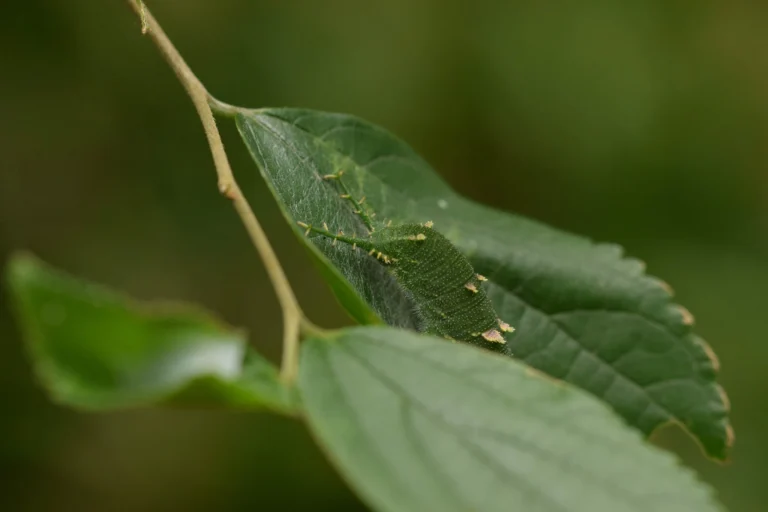Dead Leaf Butterfly (Kallima Inachus): Nature’s Master of Camouflage
Table of Contents
Introduction
The dead leaf butterfly known by its scientific name, Kallima inachus, is one of nature’s most impressive masters of disguise. At first glance, you might mistake it for a simple, withered leaf. But give it a moment, and you might just see it spread its wings to reveal a brilliant display of colors.
The Marvel of Nature’s Camouflage
Nature has a way of surprising us. And the orange oakleaf is a shining example of that. When it comes to hiding from predators, this butterfly doesn’t just rely on speed or agility.
Instead, it uses its looks. By mimicking the appearance of a dead leaf, this butterfly can stay safe from birds and other hungry creatures. It’s a smart and simple way to stay alive!
Common Names
The butterfly Kallima inachus goes by several names based on its appearance and where people find it:
- Indian OakLeaf Butterfly: Many use this name because the butterfly has a strong presence in India and its wings look like leaves.
- Orange Oakleaf: Some people notice the orange colors on its wings when they open and call it this.
- Dead Leaf Butterfly: This name comes from its amazing ability to look like a dried leaf when its wings are closed.
Each name tells us something special about the butterfly.
Scientific Classification of Kallima inachus
- Kingdom: Animalia: The dead leaf butterfly is an animal, grouped under the Animalia kingdom.
- Phylum: Arthropoda: It belongs to the Arthropoda phylum, which means it has jointed legs and a hard outer body.
- Class: Insecta: As an insect, it falls under the Insecta class, characterized by six legs, two antennas, and three main body parts.
- Order: Lepidoptera: It’s part of the Lepidoptera order, which includes all butterflies and moths.
- Family: Nymphalidae: This butterfly is a member of the Nymphalidae family, known for its vibrant wings and distinctive flight patterns.
- Genus: Kallima: The orange oakleaf belongs to the Kallima genus, recognized for its unique appearance.
- Species: K. inachus: Its specific name is Kallima inachus.
Physical Characteristics and Camouflage
Size and Shape
The dead leaf butterfly is about the size of a standard pencil, with a wingspan between 8 to 10 centimeters. And it’s very light, weighing just a few grams.
Dual Coloration
At first glance, the butterfly looks just like a dead leaf because of the brown topside of its wings. They even have patterns that look like leaf veins. But there’s a surprise! The butterfly shows bright blues and oranges under its wings to attract a mate or when it feels safe.
Comparison to Dead Leaves
The details on the butterfly’s wings are amazing. They have vein patterns, spots, and jagged edges. These features make the butterfly look like a real dried and torn leaf.
Mastery of Mimicry
This winged beauty is an expert at hiding. It blends in so well among real dead leaves that often, people can’t spot it at all. This clever trick helps it stay safe from those who might want to eat it.
Predators and Defense
Like many other creatures, this butterfly faces threats in the wild. Birds, spiders, and some reptiles often see this butterfly as a tasty snack. But this butterfly isn’t defenseless.
Its top defense is its looks. By appearing like a dead leaf, it becomes less appealing to predators. Who wants to eat a dried-up leaf, right? This clever disguise keeps many enemies at bay.
When a predator gets too close, the butterfly might suddenly reveal its vibrant underside. This sudden burst of color can startle or confuse the predator, giving the butterfly a chance to escape.
Another trick up its wing is its flight pattern. When it flies, it does so erratically, making it hard for predators to follow or catch.
These strategies, combined with its amazing camouflage, make this insect a tough target for most predators.
Dead Leaf Butterfly Facts
Origins: Historical Background, Discovery, and Naming Conventions
This Foliage Mimicker has a history as unique as its appearance. Discovered years ago in the dense forests of Tropical Asia, it left many researchers amazed at its leaf-like appearance.
The name Kallima inachus comes from Greek origins, with “Kallima” meaning “beautiful” – a fitting name for such a remarkable butterfly.
Unique Features
While many butterflies have beautiful colors, this camouflaged flyer stands out because of its dual look. On one side, it’s a brilliant, colorful butterfly.
On the other, it’s a dried-up leaf. This butterfly also has a unique way of resting. It often hangs upside down, further enhancing its leaf disguise.
Night vs. Day: Insights into Their Daily Patterns
This insect is mostly active during the day, basking in the sunlight and searching for food. But when night falls, it finds a quiet spot, often amidst real leaves, and rests.
This day-active nature makes it easier for us to spot them during our daytime adventures.
Dead Leaf Butterfly Symbolism
In Literature and Art
Artists and writers often look to nature for inspiration. The Orange Oakleaf, with its dual nature and incredible disguise, has found its way into stories and paintings.
Artists often use it to represent change, showing the butterfly transforming from a leaf-like appearance into something colorful.
Writers, on the other hand, use it as a metaphor for hidden beauty or the surprises life can offer.
Cultural and Spiritual Significance
Different cultures view the Indian oakleaf butterfly in their own unique ways. In some places, it’s a symbol of rebirth and new beginnings, given its transformation from a caterpillar. Others see it as a sign of flexibility and survival, inspired by its camouflage abilities.
Spiritually, many believe the butterfly holds lessons about finding one’s true self and revealing inner beauty.
Is the Dead Leaf Butterfly Rare?
Population Dynamics
The dead leaf butterfly’s numbers are not exactly rare, but it’s also not found everywhere. They mainly populate regions in Asia, from India to Japan.
While many of these areas have stable butterfly populations, places with increasing deforestation are seeing declines.
To keep these butterflies around, it’s essential we care for and protect their homes.
Environmental Impact: Factors Influencing Their Numbers and Habitat
The orange oakleaf butterfly thrives in lush, healthy forests. These environments offer plenty of trees and leaves for camouflage, protection from predators, and places to lay eggs.
But as more forests fall due to logging and pollution damage the greenery, the butterfly faces fewer safe-havens.
In areas experiencing heavy deforestation, we see fewer of these unique butterflies.
Life Cycle of the Dead Leaf Butterfly
Stages of Growth: From Egg to Adult
Every butterfly starts its life as a tiny egg. The orange oakleaf butterfly is no different. After a short time, the egg hatches, and out comes a caterpillar. This caterpillar eats a lot, growing bigger every day.
When it’s big enough, it forms a protective shell around itself, called a chrysalis or pupa. Inside, it transforms. And after a while, a beautiful butterfly emerges, ready to start the cycle all over again.
Life Span: How Long They Live
The orange oakleaf butterfly doesn’t live for a very long time. Once it becomes a butterfly, it usually lives for a few weeks. During this time, it looks for food, finds a mate, and lays eggs to bring the next generation to life.
Habitat and Geographic Distribution
Natural Habitats: Where They Like to Live
The Asian Marvel loves places with lots of trees and rain. These spots can be forests that lose leaves or forests that stay green all year. In the Kumaon Himalayas, you’ll find them in forests between 400 and 1,400 meters high.
Where You Can Find Them Around the World
You can see this butterfly in many countries. They live in India, Nepal, Bhutan, Bangladesh, Myanmar, southern China, Thailand, Laos, Taiwan, and Vietnam. Sometimes, people spot them in Pakistan too.
In India, they live in:
- The Himalayas: From places like Jammu and Kashmir to West Bengal.
- Central India: States like Madhya Pradesh, Jharkhand, and Andhra Pradesh.
- The Ghats: They fly in the Western Ghats and the northern parts of the Eastern Ghats.
India has many of these butterflies, but China doesn’t have as many. They can fly high, up to 2,400 meters, especially where it rains a lot.
Behavior
Diet and Feeding Patterns: What They Eat and How They Eat
The orange oakleaf butterfly isn’t picky when it’s hungry. As a butterfly, it sips nectar from flowers using its long, straw-like mouth called a proboscis. Sometimes, it also enjoys the sweet sap from trees or overripe fruits. When it’s a caterpillar, it munches on leaves.
Mating Rituals: How They Find a Partner
Finding a mate is a big deal for the orange oakleaf butterfly. They use their colorful wings to attract attention. Once they find a partner, they’ll dance around each other in a sort of aerial ballet.
After mating, the female looks for the perfect spot to lay her eggs, ensuring the next generation has a good start.
Learn How Monarch Butterflies Mate in our complete guide.
Flight Dynamics: How They Move in the Air
This butterfly has a unique way of flying. It doesn’t just glide smoothly. Instead, it flutters and darts, making it hard for predators to catch.
This zig-zag pattern also helps it blend into its surroundings, especially when it lands among leaves.
Fun Facts
Surprising Behaviors: Things They Do That Might Surprise You
- Playing Dead: When a predator comes close, it drops to the ground and stays still, pretending to be a dead leaf.
- Hanging Upside Down: This butterfly often rests by hanging upside down on twigs or branches, making it resemble a real leaf even more.
- Masters of Camouflage: Many consider the Kallima inachus one of the best butterflies at hiding in plain sight. Its wings match the look of a dead leaf so well.
- Sunbathing Butterflies: This butterfly often sits in sunny spots to warm up.
- Staying Warm: They don’t like cold weather. When temperatures drop, they find warm places to hide. If it’s too cold, they might just stay still and wait for warmer days.
Final Thoughts
The Indian leaf butterfly is a remarkable species. When its wings are closed, it becomes almost invisible in its surroundings, perfectly mimicking a dead leaf. This incredible ability is just one of the many wonders that nature offers us.
Every detail about this butterfly catches our interest, from its unique appearance to its behaviors. It reminds us to always be curious and appreciative of the small wonders around us.
So, if you’re ever exploring a forest in Asia and stumble upon a seemingly ordinary dead leaf, pause and look closely. It might just be the wings of this camouflaged flyer, gracefully hiding in plain sight.



